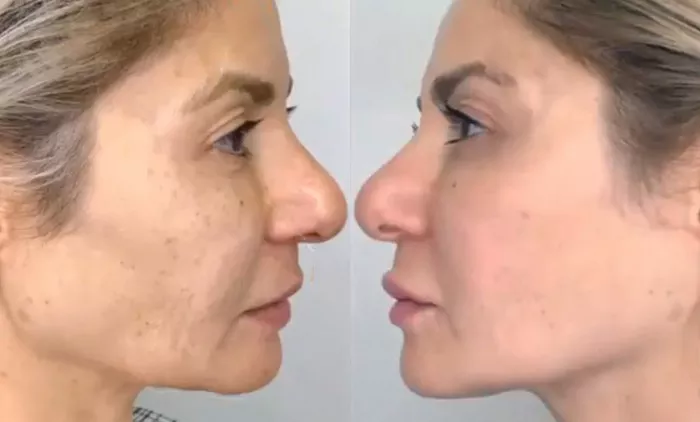Sunburn is a common skin condition that occurs when the skin is exposed to excessive amounts of ultraviolet (UV) radiation from the sun. In addition to causing pain and discomfort, sunburn can also lead to wrinkles and other signs of premature aging. In this article, we will explore the effects of sun damage on the skin, including the development of wrinkles, and discuss whether these wrinkles can go away on their own or require treatment.
The Effects of Sun Damage on the Skin
Sun damage can have a variety of negative effects on the skin, including the development of wrinkles, age spots, and a rough, leathery texture. This is because UV radiation from the sun can damage the collagen and elastin fibers in the skin, which are responsible for keeping the skin firm and elastic.
Over time, this damage can lead to the formation of wrinkles and fine lines, as well as a loss of skin elasticity and volume. Additionally, sun damage can increase the risk of skin cancer and other serious skin conditions.
Can Sunburn Wrinkles Go Away on Their Own?
Unfortunately, wrinkles caused by sunburn typically do not go away on their own. While the skin may eventually heal from the burn, the damage to the collagen and elastin fibers can be permanent, leading to the formation of wrinkles and other signs of premature aging.
This is why it is so important to protect your skin from UV radiation by wearing protective clothing, using a broad-spectrum sunscreen with an SPF of at least 30, and avoiding prolonged exposure to the sun during peak hours.
Treatment Options for Sunburn Wrinkles
While sunburn wrinkles may not go away on their own, there are several treatment options available to help reduce their appearance and improve the overall health and appearance of the skin.
One of the most effective treatments for sunburn wrinkles is a procedure called laser resurfacing. This procedure uses a laser to remove the outer layer of damaged skin, stimulating the growth of new, healthy skin cells and promoting the production of collagen and elastin fibers.
Other treatment options for sunburn wrinkles may include chemical peels, microdermabrasion, and injectable treatments like Botox and dermal fillers. These treatments can help reduce the appearance of wrinkles and improve the overall texture and tone of the skin.
Preventing Sun Damage and Wrinkles
The best way to prevent sun damage and wrinkles is to protect your skin from UV radiation. This can be done by wearing protective clothing, such as long-sleeved shirts and wide-brimmed hats, using a broad-spectrum sunscreen with an SPF of at least 30, and avoiding prolonged exposure to the sun during peak hours.
It is also important to maintain a healthy lifestyle, including eating a balanced diet, staying hydrated, and getting regular exercise. Additionally, avoiding smoking and excessive alcohol consumption can help reduce the risk of premature aging and other negative effects on the skin.
Conclusion
Sunburn can have a variety of negative effects on the skin, including the development of wrinkles and other signs of premature aging. While these wrinkles may not go away on their own, there are several treatment options available to help reduce their appearance and improve the overall health and appearance of the skin.
By taking steps to protect your skin from UV radiation and maintaining a healthy lifestyle, you can help prevent sun damage and reduce the risk of wrinkles and other skin conditions. Be sure to consult with a qualified dermatologist or skincare professional to develop a customized treatment plan that meets your individual needs and goals.
FAQs
1. Are sunburn wrinkles permanent?
Sunburn wrinkles, also known as photoaging wrinkles, can become permanent over time if not properly treated and protected from further sun damage. Prolonged exposure to ultraviolet (UV) radiation from the sun can damage the skin’s collagen and elastin fibers, leading to the formation of wrinkles, fine lines, and other signs of aging. While some sunburn wrinkles may fade or improve with proper skincare and protection from the sun, others may become more pronounced and permanent without intervention.
2. Can you reverse sun damage wrinkles?
While it may not be possible to completely reverse sun damage wrinkles, certain treatments and skincare practices can help minimize their appearance and prevent further damage. These may include topical retinoids, antioxidants, moisturizers, and sunscreens to protect the skin from UV radiation. Additionally, procedures such as chemical peels, microdermabrasion, laser therapy, and injectable fillers may be recommended by a dermatologist or plastic surgeon to improve the texture and appearance of sun-damaged skin.
3. How do you treat sunburn wrinkles?
Treatment for sunburn wrinkles typically involves a combination of skincare products, lifestyle changes, and professional treatments. Using sunscreen daily with a high SPF, wearing protective clothing, avoiding prolonged sun exposure, and seeking shade during peak hours can help prevent further sun damage. Additionally, incorporating skincare products containing retinoids, antioxidants, hyaluronic acid, and peptides can help improve the appearance of sun-damaged skin. For more severe wrinkles, dermatological treatments such as laser therapy, chemical peels, microdermabrasion, or injectable fillers may be recommended.
4. Why has my skin gone wrinkly after sunburn?
Sunburn can lead to the development of wrinkles and fine lines due to the damage caused by UV radiation to the skin’s collagen and elastin fibers. UV exposure stimulates the production of matrix metalloproteinases (MMPs), enzymes that break down collagen and elastin, leading to decreased skin elasticity and increased wrinkling. Additionally, prolonged sun exposure can result in dehydration, loss of skin moisture, and damage to the skin’s DNA, contributing to the formation of wrinkles and other signs of premature aging. Therefore, it’s essential to protect your skin from sunburn and UV damage by using sunscreen, seeking shade, and wearing protective clothing when outdoors.


